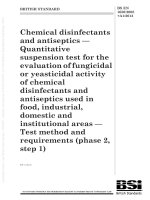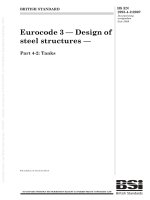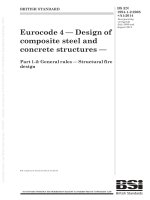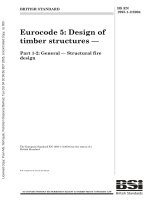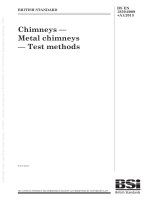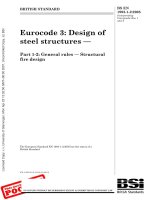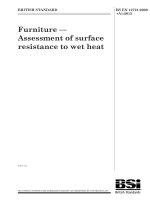Bsi bs en 61753 088 2 2013
Bạn đang xem bản rút gọn của tài liệu. Xem và tải ngay bản đầy đủ của tài liệu tại đây (1.29 MB, 30 trang )
BS EN 61753-088-2:2013
BSI Standards Publication
Fibre optic interconnecting
devices and passive
components — Performance
standard
Part 088-2: Non-connectorized single-mode
fibre optic LAN WDM devices with channel
spacing of 800 GHz for category C —
Controlled environments
BRITISH STANDARD
BS EN 61753-088-2:2013
National foreword
This British Standard is the UK implementation of EN 61753-088-2:2013. It
is identical to IEC 61753-088-2:2013. It supersedes DD IEC/PAS 61753-088-2:
2010 which is withdrawn.
The UK participation in its preparation was entrusted by Technical
Committee GEL/86, Fibre optics, to Subcommittee GEL/86/2, Fibre optic
interconnecting devices and passive components.
A list of organizations represented on this committee can be obtained on
request to its secretary.
This publication does not purport to include all the necessary provisions of
a contract. Users are responsible for its correct application.
© The British Standards Institution 2013
Published by BSI Standards Limited 2013
ISBN 978 0 580 71067 4
ICS 33.180.20
Compliance with a British Standard cannot confer immunity from
legal obligations.
This British Standard was published under the authority of the
Standards Policy and Strategy Committee on 31 July 2013.
Amendments issued since publication
Amd. No.
Date
Text affected
BS EN 61753-088-2:2013
EN 61753-088-2
EUROPEAN STANDARD
NORME EUROPÉENNE
EUROPÄISCHE NORM
June 2013
ICS 33.180.20
English version
Fibre optic interconnecting devices and passive components Performance standard Part 088-2: Non-connectorized single-mode fibre optic LAN WDM devices
with channel spacing of 800 GHz for category C Controlled environments
(IEC 61753-088-2:2013)
Dispositifs d’interconnexion et
composants passifs à fibres optiques Norme de performance Partie 088-2: Dispositifs LAN WDM à
fibres optiques unimodales, non
connectorisés, avec un espacement entre
canaux de 800 GHz, pour catégorie C Environnements contrôlés
(CEI 61753-088-2:2013)
Lichtwellenleiter Verbindungselemente und passive
Bauteile - Betriebsverhalten Teil 088-2: Nicht mit Steckverbindern
versehene Einmoden LWL-LAN-WDMGeräte mit Kanalweiten von 800 GHz für
Kategorie C - Kontrollierte Umgebung
(IEC 61753-088-2:2013)
This European Standard was approved by CENELEC on 2013-04-22. CENELEC members are bound to comply
with the CEN/CENELEC Internal Regulations which stipulate the conditions for giving this European Standard
the status of a national standard without any alteration.
Up-to-date lists and bibliographical references concerning such national standards may be obtained on
application to the CEN-CENELEC Management Centre or to any CENELEC member.
This European Standard exists in three official versions (English, French, German). A version in any other
language made by translation under the responsibility of a CENELEC member into its own language and notified
to the CEN-CENELEC Management Centre has the same status as the official versions.
CENELEC members are the national electrotechnical committees of Austria, Belgium, Bulgaria, Croatia, Cyprus,
the Czech Republic, Denmark, Estonia, Finland, Former Yugoslav Republic of Macedonia, France, Germany,
Greece, Hungary, Iceland, Ireland, Italy, Latvia, Lithuania, Luxembourg, Malta, the Netherlands, Norway, Poland,
Portugal, Romania, Slovakia, Slovenia, Spain, Sweden, Switzerland, Turkey and the United Kingdom.
CENELEC
European Committee for Electrotechnical Standardization
Comité Européen de Normalisation Electrotechnique
Europäisches Komitee für Elektrotechnische Normung
Management Centre: Avenue Marnix 17, B - 1000 Brussels
© 2013 CENELEC -
All rights of exploitation in any form and by any means reserved worldwide for CENELEC members.
Ref. No. EN 61753-088-2:2013 E
BS EN 61753-088-2:2013
EN 61753-088-2:2013
-2-
Foreword
The text of document 86B/3549/FDIS, future edition 1 of IEC 61753-088-2, prepared by SC 86B "Fibre
optic interconnecting devices and passive components” of IEC/TC 86 “Fibre optics" was submitted to
the IEC-CENELEC parallel vote and approved by CENELEC as EN 61753-088-2:2013.
The following dates are fixed:
•
•
latest date by which the document has
to be implemented at national level by
publication of an identical national
standard or by endorsement
latest date by which the national
standards conflicting with the
document have to be withdrawn
(dop)
2014-01-22
(dow)
2016-04-22
Attention is drawn to the possibility that some of the elements of this document may be the subject of
patent rights. CENELEC [and/or CEN] shall not be held responsible for identifying any or all such
patent rights.
Endorsement notice
The text of the International Standard IEC 61753-088-2:2013 was approved by CENELEC as a
European Standard without any modification.
In the official version, for Bibliography, the following notes have to be added for the standards indicated:
IEC 61300-3-2
NOTE
Harmonised as EN 61300-3-2.
IEC 61753-021-2
NOTE
Harmonised as EN 61753-021-2.
-3-
BS EN 61753-088-2:2013
EN 61753-088-2:2013
Annex ZA
(normative)
Normative references to international publications
with their corresponding European publications
The following documents, in whole or in part, are normatively referenced in this document and are
indispensable for its application. For dated references, only the edition cited applies. For undated
references, the latest edition of the referenced document (including any amendments) applies.
NOTE When an international publication has been modified by common modifications, indicated by (mod), the relevant EN/HD
applies.
Publication
Year
Title
EN/HD
Year
IEC 60793-2-50
-
Optical fibres EN 60793-2-50
Part 2-50: Product specifications - Sectional
specification for class B single-mode fibres
IEC 61300
Series Fibre optic interconnecting devices and
passive components - Basic test and
measurement procedures
EN 61300
Series
IEC 61300-2-1
-
Fibre optic interconnecting devices and
passive components - Basic test and
measurement procedures Part 2-1: Tests - Vibration (sinusoidal)
EN 61300-2-1
-
IEC 61300-2-4
-
Fibre optic interconnecting devices and
passive components - Basic test and
measurement procedures Part 2-4: Tests - Fibre/cable retention
EN 61300-2-4
-
IEC 61300-2-9
-
Fibre optic interconnecting devices and
passive components - Basic test and
measurement procedures Part 2-9: Tests - Shock
EN 61300-2-9
-
IEC 61300-2-17
-
Fibre optic interconnecting devices and
passive components - Basic test and
measurement procedures Part 2-17: Tests - Cold
EN 61300-2-17
-
IEC 61300-2-18
-
Fibre optic interconnecting devices and
passive components - Basic test and
measurement procedures Part 2-18: Tests - Dry heat - High
temperature endurance
EN 61300-2-18
-
IEC 61300-2-19
-
Fibre optic interconnecting devices and
EN 61300-2-19
passive components - Basic test and
measurement procedures Part 2-19: Tests - Damp heat (steady state)
-
IEC 61300-2-22
-
Fibre optic interconnecting devices and
passive components - Basic test and
measurement procedures Part 2-22: Tests - Change of temperature
EN 61300-2-22
-
IEC 61300-2-42
-
Fibre optic interconnecting devices and
passive components - Basic test and
measurement procedures Part 2-42: Tests - Static side load for
connectors
EN 61300-2-42
-
-
BS EN 61753-088-2:2013
EN 61753-088-2:2013
-4-
Publication
Year
Title
EN/HD
Year
IEC 61300-3-7
-
Fibre optic interconnecting devices and
EN 61300-3-7
passive components - Basic test and
measurement procedures Part 3-7: Examinations and measurements Wavelength dependence of attenuation and
return loss of single mode components
-
IEC 61300-3-20
-
Fibre optic interconnecting devices and
EN 61300-3-20
passive components - Basic test and
measurement procedures Part 3-20: Examinations and measurements
- Directivity of fibre optic branching devices
-
IEC 61300-3-28
-
Fibre optic interconnecting devices and
EN 61300-3-28
passive components - Basic test and
measurement procedures Part 3-28: Examinations and measurements
- Transient loss
-
IEC 61300-3-29
-
Fibre optic interconnecting devices and
EN 61300-3-29
passive components - Basic test and
measurement procedures Part 3-29: Examinations and measurements
- Measurement techniques for characterising
the amplitude of the spectral transfer
function of DWDM components
-
IEC 61753-1
2007
Fibre optic interconnecting devices and
EN 61753-1
passive components performance standard Part 1: General and guidance for
performance standards
2007
IEC 62074-1
-
EN 62074-1
-
ITU-T
Recommendation
G.959.1
-
Fibre optic interconnecting devices and
passive components - Fibre optic WDM
devices Part 1: Generic specification
Optical transport network physical layer
interfaces
-
-
IEEE P802.3ba
-
Carrier Sense Multiple Access with Collision Detection (CSMA/CD) Access Method and
Physical Layer Specifications
-
–2–
BS EN 61753-088-2:2013
61753-088-2 © IEC:2013
CONTENTS
1
Scope ............................................................................................................................... 6
2
Normative references ....................................................................................................... 6
3
Terms and definitions ....................................................................................................... 7
4
Test conditions ................................................................................................................. 8
5
Test report ........................................................................................................................ 8
6
Reference components ..................................................................................................... 9
7
Performance requirements ............................................................................................... 9
7.1
7.2
7.3
Annex A
Channel requirements ............................................................................................. 9
Dimensions ............................................................................................................. 9
Test details and requirements ................................................................................. 9
(normative) Sample size ........................................................................................ 15
Annex B (informative) Logarithmic transfer matrix for an integrated 1 × 4 LAN WDM
device ................................................................................................................................... 16
Annex C (informative) Logarithmic transfer matrix for an individual 1 × 2 LAN WDM
device ................................................................................................................................... 18
Annex D (informative) General information for applications of integrated 1 × 4 LAN
WDM devices ........................................................................................................................ 22
Annex E (informative) General information for internal configurations of integrated 1 ×
4 LAN WDM devices ............................................................................................................. 23
Bibliography .......................................................................................................................... 25
Figure 1 – Configuration of integrated 1 × 4 LAN WDM device ................................................ 8
Figure 2 – Configuration of individual 1 × 2 LAN WDM device ................................................. 8
Figure D.1 – Block diagram for 100GBASE-LR4 and 100GBASE-ER4 transmit/receive
paths .................................................................................................................................... 22
Figure E.1 – Configuration example of serial-type integrated 1 × 4 LAN WDM device
(DEMUX) .............................................................................................................................. 23
Figure E.2 – Configuration example of serial-type integrated 1 × 4 LAN WDM device
(MUX) ................................................................................................................................... 23
Figure E.3 – Configuration example of tree-type integrated 1 × 4 LAN WDM device
(MUX/DEMUX) ...................................................................................................................... 24
Table 1 – Channel requirements ............................................................................................. 9
Table 2 – Test details and requirements ............................................................................... 10
Table A.1 – Number of samples for each test ........................................................................ 15
Table B.1 – Logarithmic transfer matrix for channel 1: Frequency range of 231,584 –
231,216 THz (≈1 294,53 – 1 296,59 nm) .............................................................................. 16
Table B.2 – Logarithmic transfer matrix for channel 2: Frequency range of 230,784 –
230,416 THz (≈1 299,02 – 1 301,09 nm) .............................................................................. 16
Table B.3 – Logarithmic transfer matrix for channel 3: Frequency range of 229,984 –
229,616 THz (≈1 303,54 – 1 305,63 nm) .............................................................................. 16
Table B.4 – Logarithmic transfer matrix for channel 4: Frequency range of 229,184 –
228,816 THz (≈1 308,09 – 1 310,19 nm) .............................................................................. 17
BS EN 61753-088-2:2013
61753-088-2 © IEC:2013
–3–
Table C.1 – Logarithmic transfer matrix for channel 1: Frequency range of 231,584 –
231,216 THz (≈1 294,53 – 1 296,59 nm) .............................................................................. 18
Table C.2 – Logarithmic transfer matrix for channel 2: Frequency range of 230,784 –
230,416 THz (≈1 299,02 – 1 301,09 nm) .............................................................................. 18
Table C.3 – Logarithmic transfer matrix for channel 3: Frequency range of 229,984 –
229,616 THz (≈1 303,54 – 1 305,63 nm) .............................................................................. 18
Table C.4 – Logarithmic transfer matrix for channel 4: Frequency range of 229,184 –
228,816 THz (≈1 308,09 – 1 310,19 nm) .............................................................................. 18
Table C.5 – Logarithmic transfer matrix for channel 1: Frequency range of 231,584 –
231,216 THz (≈1 294,53 – 1 296,59 nm) .............................................................................. 19
Table C.6 – Logarithmic transfer matrix for channel 2: Frequency range of 230,784 –
230,416 THz (≈1 299,02 – 1 301,09 nm) .............................................................................. 19
Table C.7 – Logarithmic transfer matrix for channel 3: Frequency range of 229,984 –
229,616 THz (≈1 303,54 – 1 305,63 nm) .............................................................................. 19
Table C.8 – Logarithmic transfer matrix for channel 4: Frequency range of 229,184 –
228,816 THz (≈1 308,09 – 1 310,19 nm) .............................................................................. 19
Table C.9 – Logarithmic transfer matrix for channel 1: Frequency range of 231,584 –
231,216 THz (≈1 294,53 – 1 296,59 nm) .............................................................................. 19
Table C.10 – Logarithmic transfer matrix for channel 2: Frequency range of 230,784 –
230,416 THz (≈1 299,02 – 1 301,09 nm) .............................................................................. 20
Table C.11 – Logarithmic transfer matrix for channel 3: Frequency range of 229,984 –
229,616 THz (≈1 303,54 – 1 305,63 nm) .............................................................................. 20
Table C.12 – Logarithmic transfer matrix for channel 4: Frequency range of 229,184 –
228,816 THz (≈1 308,09 – 1 310,19 nm) .............................................................................. 20
Table C.13 – Logarithmic transfer matrix for channel 1: Frequency range of 231,584 –
231,216 THz (≈1 294,53 – 1 296,59 nm) .............................................................................. 20
Table C.14 – Logarithmic transfer matrix for channel 2: Frequency range of 230,784 –
230,416 THz (≈1 299,02 – 1 301,09 nm) .............................................................................. 20
Table C.15 – Logarithmic transfer matrix for channel 3: Frequency range of 229,984 –
229,616 THz (≈1 303,54 – 1 305,63 nm) .............................................................................. 21
Table C.16 – Logarithmic transfer matrix for channel 4: Frequency range of 229,184 –
228,816 THz (≈1 308,09 – 1 310,19 nm) .............................................................................. 21
–6–
BS EN 61753-088-2:2013
61753-088-2 © IEC:2013
FIBRE OPTIC INTERCONNECTING DEVICES
AND PASSIVE COMPONENTS –
PERFORMANCE STANDARD –
Part 088-2: Non-connectorized single-mode fibre optic LAN WDM
devices with channel spacing of 800 GHz for category C –
Controlled environments
1
Scope
This part of IEC 61753 contains the minimum initial test and measurement requirements and
severities which a non-connectorized single-mode fibre optic Local Area Network Wavelength
Division Multiplexing (LAN WDM) device with channel spacing of 800 GHz needs to satisfy in
order to be categorized as meeting the requirements of Category C – Controlled environments,
as defined in Annex A of IEC 61753-1:2007. The applications of LAN WDM devices are optical
MUX and DEMUX for 100GBASE-LR4 (required operating range of 2 m to 10 km) and
100GBASE-ER4 (required operating range of 2 m to 30 km) defined in IEEE P802.3ba, as
shown in Annex D. The requirements cover both an integrated 1 × 4 LAN WDM device and an
individual 1 × 2 LAN WDM device for cascaded module construction.
2
Normative references
The following documents, in whole or in part, are normatively referenced in this document and
are indispensable for its application. For dated references, only the edition cited applies. For
undated references, the latest edition of the referenced document (including any
amendments) applies.
IEC 60793-2-50, Optical fibres – Part 2-50: Product specifications – Sectional specification for
class B single-mode fibres 1
IEC 61300 (all parts), Fibre optic interconnecting devices and passive components – Basic
test and measurement procedures
IEC 61300-2-1, Fibre optic interconnecting devices and passive components – Basic test and
measurement procedures – Part 2-1: Tests – Vibration (sinusoidal)
IEC 61300-2-4, Fibre optic interconnecting devices and passive components – Basic test and
measurement procedures – Part 2-4: Tests – Fibre/cable retention
IEC 61300-2-9, Fibre optic interconnecting devices and passive components – Basic test and
measurement procedures – Part 2-9: Tests – Shock
IEC 61300-2-17, Fibre optic interconnecting devices and passive components – Basic test and
measurement procedures – Part 2-17: Tests – Cold
IEC 61300-2-18, Fibre optic interconnecting devices and passive components – Basic test and
measurement procedures – Part 2-18: Tests – Dry heat – High temperature endurance
IEC 61300-2-19, Fibre optic interconnecting devices and passive components – Basic test and
measurement procedures – Part 2-19: Tests – Damp heat (steady state)
—————————
1 A fourth edition is due to be published shortly.
BS EN 61753-088-2:2013
61753-088-2 © IEC:2013
–7–
IEC 61300-2-22, Fibre optic interconnecting devices and passive components – Basic test and
measurement procedures – Part 2-22: Tests – Change of temperature
IEC 61300-2-42, Fibre optic interconnecting devices and passive components – Basic test and
measurement procedures – Part 2-42: Tests – Static side load for connectors
IEC 61300-3-7, Fibre optic interconnecting devices and passive components – Basic test and
measurement procedures – Part 3-7: Examinations and measurements – Wavelength
dependence of attenuation and return loss of single mode components
IEC 61300-3-20, Fibre optic interconnecting devices and passive components – Basic test and
measurement procedures – Part 3-20: Examinations and measurements – Directivity of fibre
optic branching devices
IEC 61300-3-28, Fibre optic interconnecting devices and passive components – Basic test
and measurement procedures – Part 3-28: Examinations and measurements – Transient loss
IEC 61300-3-29, Fibre optic interconnecting devices and passive components – Basic test
and measurement procedures – Part 3-29: Examinations and measurements – Measurement
techniques for characterizing the amplitude of the spectral transfer function of DWDM
components
IEC 61753-1:2007, Fibre optic interconnecting devices and passive components performance
standard – Part 1: General and guidance for performance standard
IEC 62074-1, Fibre optic interconnecting devices and passive components – Fibre optic WDM
devices – Part 1: Generic specification
ITU-T Recommendation G.959.1, Optical transport network physical layer interfaces
IEEE P802.3ba, Carrier Sense Multiple Access with Collision Detection (CSMA/CD) Access
Method and Physical Layer Specifications
3
Terms and definitions
For the purposes of this document, the terms and definitions given in IEC 62074-1, as well as
the following, apply.
3.1
LAN WDM device
wavelength-selective branching device which performs the function both of wavelength
multiplexing and demultiplexing with DWDM channel frequency of 231,4 THz, 230,6 THz,
229,8 THz, and 229,0 THz, where the channel frequency spacing is 800 GHz
3.2
integrated 1 × 4 LAN WDM device
single-mode fibre-pigtailed wavelength-selective branching device as shown in Figure 1.
There is 1 common port (P0) and 4 input/output ports (P1-P4) corresponding to the 4
frequency channels
–8–
Input/
output
BS EN 61753-088-2:2013
61753-088-2 © IEC:2013
Outputs/
inputs
P1(λ1)
P0(λ1,λ2,λ3,λ4)
P2(λ2)
P3(λ3)
P4(λ4)
IEC 476/13
Figure 1 – Configuration of integrated 1 × 4 LAN WDM device
3.3
individual 1 × 2 LAN WDM device
single-mode fibre-pigtailed wavelength-selective branching device as shown in Figure 2.
There are 4 types of individual 1 × 2 LAN WDM device, corresponding to the 4 frequency
channels. There is 1 common port (P0) and 2 input/output ports (P1, P2). The signal of the
corresponding channel frequency passes through between P0 and P1. The signals of non
corresponding channel frequencies pass through between P0 and P2.
Input/
output
P0(λ1,λ2,λ3,λ4)
Outputs/
inputs
P1(λi)
P2(λj(j≠ i))
IEC 477/13
Figure 2 – Configuration of individual 1 × 2 LAN WDM device
4
Test conditions
Unless otherwise specified, all test methods are in accordance with the IEC 61300 series.
LAN WDM devices used for each test are intended to be previously unstressed new samples
but may also be selected from previously used samples if desired. The samples shall have
pigtails of single-mode fibres as per IEC 60793-2-50, category B1.1, B1.3 or B6 in either
coated fibres (primary and secondary) or reinforced cable format. All measurements shall be
carried out under standard atmospheric conditions, unless otherwise specified. If the device is
provided with an active temperature control, this shall be set at the set-point specified by the
manufacturer.
The requirements apply to every combination of input and output ports.
All tests are to be carried out to validate performance over the required operating channel
frequency range. As a result, single or multiple spectral bands may be chosen for the
qualification and differing target specifications may be assigned to each spectral band.
5
Test report
Fully documented test reports and supporting evidence shall be prepared and be available for
inspection as evidence that the tests have been carried out and complied with.
BS EN 61753-088-2:2013
61753-088-2 © IEC:2013
6
–9–
Reference components
The test for these components does not require the use of reference components.
7
7.1
Performance requirements
Channel requirements
Table 1 shows channel requirements (design information) as specified by IEEE P802.3ab and
ITU-T Recommendation G.959.1.
Table 1 – Channel requirements
No
1
Items
Centre frequency
Requirements
Channel 1: 231,4 THz (≑ 1 295,56 nm)
Channel 2: 230,6 THz (≑ 1 300,05 nm)
Channel 3: 229,8 THz (≑ 1 304,58 nm)
Channel 4: 229,0 THz (≑ 1 309,14 nm)
2
Channel spacing
800 GHz
3
Channel frequency range
Centre frequency ± 184 GHz
Channel 1: 231,584 – 231,216 THz (≑ 1 294,53 – 1 296,59 nm)
Channel 2: 230,784 – 230,416 THz (≑ 1 299,02 – 1 301,09 nm)
Channel 3: 229,984 – 229,616 THz (≑ 1 303,54 – 1 305,63 nm)
Channel 4: 229,184 – 228,816 THz (≑ 1 308,09 – 1 310,19 nm)
7.2
Dimensions
Dimensions shall comply with those given in appropriate manufacturers drawings.
7.3
Test details and requirements
A minimum length of fibre or cable of 2,0 m per port shall be included in all climatic and
environmental test chambers. Even though a wavelength range is used instead of the precise
required frequency range, the wavelength range required includes the required frequency
range.
– 10 –
BS EN 61753-088-2:2013
61753-088-2 © IEC:2013
Table 2 – Test details and requirements (1 of 5)
No
1
Tests
Attenuation
(insertion loss)
IEC 61300-3-29
Requirements
Maximum allowable
attenuation (insertion loss)
over the channel frequency
range according to Table 1:
2,0 dB (Integrated 1 × 4 LAN
WDM device) See Annex B.
0,85 dB for P0-P1 (Individual
1 × 2 LAN WDM device) See
Annex C.
Details
Method:
A and B can be applicable
Launch fibre length:
≥ 2,0 m
Wavelength scanning
range
1 290 – 1 315 nm
Wavelength resolution
≤ 0,05 nm
Wavelength accuracy
≤ ± 0,025 nm
Step size
≤ 0,025 nm
0,45 dB for P0-P2 (Individual
1 × 2 LAN WDM device) See
Annex C
The insertion loss shall be
determined as the worst
case over all states of
polarization.
Test results should be
obtained under
measurement uncertainty
of ± 0,05 dB
2
Adjacent:
channel isolation
IEC 61300-3-29
Minimum allowable adjacent
channel isolation over the
channel frequency range
according to Table 1:
25 dB (Integrated 1 × 4 LAN
WDM device) See Annex B.
25 dB for P0-P1 (Individual
1 × 2 LAN WDM device) See
Annex C.
14 dB for P0-P2 (Individual
1 × 2 LAN WDM device) See
Annex C
Method:
A and B can be applicable
Launch fibre length:
≥ 2,0 m
Wavelength scanning
range
1 290 – 1 315 nm
Wavelength resolution
≤ 0,05 nm
Wavelength accuracy
≤ ± 0,025 nm
Step size
≤ 0,025 nm
The adjacent channel
isolation is specified only for
DEMUX.
The adjacent channel
isolation shall be
determined as the worst
case over all states of
polarization.
Test results should be
obtained under measurement uncertainty of ± 0,5 dB
BS EN 61753-088-2:2013
61753-088-2 © IEC:2013
– 11 –
Table 2 (2 of 5)
No
3
Tests
Non-adjacent
channel
Isolation
IEC 61300-3-29
Requirements
Minimum allowable nonadjacent channel isolation
over the channel frequency
range according to Table 1:
35 dB (Integrated 1 × 4 LAN
WDM device) See Annex B.
35 dB for P0-P1 (Individual
1 × 2 LAN WDM device) See
Annex C.
Details
Method:
A and B can be applicable
Launch fibre length:
≥ 2,0 m
Wavelength scanning
range
1 290 – 1 315 nm
Wavelength resolution
≤ 0,05 nm
Wavelength accuracy
≤ ± 0,025 nm
Step size
≤ 0,025 nm
14 dB for P0-P2 (Individual
1 × 2 LAN WDM device) See
Annex C
The non-adjacent channel
isolation is specified only for
DEMUX.
The non-adjacent channel
isolation shall be
determined as the worst
case over all states of
polarization.
Test results should be
obtained under
measurement uncertainty
of ± 0,5 dB
4
Return loss
IEC 61300-3-7
Minimum allowable return
loss over the channel
frequency range according to
Table 1:
Method:
A, B, C and D can be
applicable.
Launch fibre length
≥ 2,0 m
Test results should be
obtained under measurement
uncertainty of ± 1 dB.
40 dB Grade R
All ports not under test shall
be terminated to avoid
unwanted reflections
contributing to the
measurement
5
Directivity
IEC 61300-3-20
Maximum allowable directivity
over the channel frequency
range according to Table 1:
50 dB Grade U
Launch fibre length:
≥ 2,0 m
Source:
Laser diode
Test results should be
obtained under measurement
uncertainty of ± 1 dB.
All ports not under test shall
be terminated to avoid
unwanted reflections
contributing to the
measurement.
The directivity shall be
measured between any pair
of input or output ports
– 12 –
BS EN 61753-088-2:2013
61753-088-2 © IEC:2013
Table 2 (3 of 5)
N°
6
Tests
Requirements
Details
Polarization
dependent loss
(PDL)
Maximum allowable PDL over
the channel frequency range
according to Table 1:
Method:
A and B can be applicable
Launch fibre length:
≥ 2,0 m
IEC 61300-3-29
0,5 dB for 1 x 4
Wavelength scanning
range:
1 290 – 1 315 nm
Wavelength resolution:
≤ 0,05 nm
Wavelength accuracy:
≤ ± 0,025 nm
0,2 dB for 1 x 2
Step size
≤ 0,025 nm
Test results should be
obtained under measurement
uncertainty of ± 0,05 dB
7
Optical power
handling
IEC 61300-2-14
Before and after the test, the
limits of insertion loss,
adjacent channel isolation,
non-adjacent channel isolation
and return loss of test no. 1, 2,
3 and 4 shall be met.
During the test, the insertion
loss change is monitored.
During and after the test, the
insertion loss change shall be
within ± 0,3 dB of the initial
value.
Method:
2
Input power for shortterm test:
200 mW, 400 mW, 600 mW,
800 mW, (continuing in
increments of 200 mW)
Duration of the optical
power exposure:
500 h (long-term test)
Temperature:
60 °C ± 2 °C
Note:
Input power for the long-term
test is determined by he
short-term test.
Test results should be
obtained under attenuation
measurement uncertainty of
less than ± 0,05 dB.
Test results should be
obtained under return loss
measurement uncertainty of
less than ± 1 dB
8
Cold:
IEC 613002-17
Before and after the test, the
limits of insertion loss,
adjacent channel isolation,
non-adjacent channel isolation
and return loss of test no. 1, 2,
3 and 4 shall be met.
The insertion loss change after
the test shall be within ±
0,3 dB of the initial value
Temperature:
–10 °C ± 2 °C
Duration of exposure:
96 h
BS EN 61753-088-2:2013
61753-088-2 © IEC:2013
– 13 –
Table 2 (4 of 5)
No
9
Tests
High temperature
endurance
IEC 61300-2-18
Requirements
Before and after the test, the limits
of insertion loss, adjacent channel
isolation, non-adjacent channel
isolation and return loss of test no.
1, 2, 3 and 4 shall be met.
Details
Temperature:
+60 °C ± 2 °C
Duration of exposure
96 h
Temperature:
+40°C ± 2 °C
Relative humidity:
93 + 2 % RH
The insertion loss change after the
test shall be within
± 0,3 dB of the initial value
10
Damp heat
(steady state)
IEC 61300-2-19
Before and after the test, the limits of
insertion loss, isolation and return
loss of test no. 1, 2 and 3 shall be
met.
Duration of exposure
During the test, the insertion loss
change is monitored. During and after
the test, the insertion loss change
shall be within ± 0,3 dB of the initial
value.
−3
96 h
During the test, the adjacent and
non-adjacent isolation changes are
monitored. The sum of the initial
values and the changes of the
isolations shall be within the value
defined at test no. 2 and 3
11
Change of
temperature
IEC 61300-2-22
Before and after the test, the limits of
insertion loss, adjacent channel
isolation, non-adjacent channel
isolation and return loss of test no. 1,
2, 3 and 4 shall be met.
High temperature:
+60 °C ± 2 °C
Low temperature:
–10 °C ± 2 °C
Number of cycles:
Duration at extreme
temperature:
5
During the test, the insertion loss
change is monitored. During and after Rate of change:
the test, the insertion loss change
Maximum interval
shall be within ± 0,3 dB of the initial
between
value.
measurements
During the test, the adjacent and
non-adjacent isolation changes are
monitored. The sum of the initial
values and the changes of the
isolations shall be within the value
defined at test no. 2 and 3
12
Vibration
IEC 61300-2-1
IEC 61300-3-28
Before and after the test, the limits of
insertion loss, adjacent channel
isolation, non-adjacent channel
isolation and return loss of test no. 1,
2, 3 and 4 shall be met.
1 °C/min
30 min
Frequency range:
5 Hz – 55 Hz.
Number of axes:
3 orthogonal axes
Number of sweeps:
15/axis
Sweep rate:
During the test, the insertion loss
change is monitored. During and after Amplitude
the test, the insertion loss change
shall be within ± 0,3 dB of the initial
value.
During the test, the adjacent and
non-adjacent isolation changes are
monitored. The sum of the initial
values and the changes of the
isolations shall be within the value
defined at test no. 2 and 3
60 min
1 octave/min
0,75 mm
– 14 –
BS EN 61753-088-2:2013
61753-088-2 © IEC:2013
Table 2 (5 of 5)
No
13
Tests
Shock
IEC 61300-2-9
Requirements
Details
Acceleration:
Before and after the test, the
limits of insertion loss,
adjacent channel isolation,
non-adjacent channel isolation
and return loss of test no. 1,
2, 3 and 4 shall be met.
The insertion loss change
after the test shall be within
± 0,3 dB of the initial value.
Duration:
Number of axis:
Number of shocks:
Components: 5 000 m/s 2
Modules:
0,125 kg < module mass
≤ 0,225 kg: 2 000 m/s 2
0,225 kg < module mass ≤ 1 kg:
500 m/s 2
1 ms, half sine pulse
3 axes in 2 directions
2 shocks per axis, 12 shock in
total
14
Optical fibre
cable flexing
IEC 61300-2-44
Tensile force:
Before and after the test, the
limits of insertion loss,
Number of cycles:
adjacent channel isolation,
non-adjacent channel isolation
and return loss of test no. 1,
2, 3 and 4 shall be met.
2 N for reinforced cable
30 cycles ± 90°
The insertion loss change
after the test shall be within
± 0,3 dB of the initial value
15
Fibre/cable
retention
IEC 61300-2-4
Magnitude and rate
Before and after the test, the
of application:
limits of insertion loss,
adjacent channel isolation,
non-adjacent channel isolation
and return loss of test no. 1,
2, 3 and 4 shall be met.
The insertion loss change
after the test shall be within ±
0,3 dB of the initial value
Duration of the test:
(10 ± 1) N at 5 N/s for
reinforced cables
(5,0 ± 0,5) N at 0,5 N/s for
secondary coated fibres
(2,0 ± 0,2) N at 0,5 N/s for
primary coated fibres
120 s duration at 10 N
60 s duration at 2 N or 5 N
16
Static side load
IEC 61300-2-42
Before and after the test, the
limits of insertion loss,
adjacent channel isolation,
non-adjacent channel isolation
and return loss of test no. 1,
2, 3 and 4 shall be met.
The insertion loss change
after the test shall be within
± 0,3 dB of the initial value
Point of application
of tensile load:
0,3 m from the exit point of the
fibre / cable from the specimen.
Method of mounting:
The sample shall be rigidly
mounted such that the load is
only applied to the fibre/cable
retention mechanism
Magnitude and
duration of the
tensile load:
1 N for 1 h for reinforced cable
Direction of
application:
0,2 N for 5 min for secondary
coated fibres
Two mutually perpendicular
directions
BS EN 61753-088-2:2013
61753-088-2 © IEC:2013
– 15 –
Annex A
(normative)
Sample size
The number of samples to be evaluated for each test is defined in the sample size column in
the following Table A.1.
Table A.1 – Number of samples for each test
No
Tests
Sample size
1
Attenuation (insertion loss)
12
2
Adjacent channel isolation
12
3
Non-adjacent channel Isolation
12
4
Return loss
12
5
Directivity
12
6
Polarisation dependent loss (PDL)
12
7
Optical power handling
6
8
Cold
6
9
High temperature endurance
6
10
Damp heat (steady state)
6
11
Change of temperature
6
12
Vibration (sinusoidal)
6
13
Shock
6
14
Optical fibre cable flexing
6
15
Fibre/cable retention
6
16
Static side load
6
BS EN 61753-088-2:2013
61753-088-2 © IEC:2013
– 16 –
Annex B
(informative)
Logarithmic transfer matrix for
an integrated 1 × 4 LAN WDM device
Tables B.1 to B.4 show logarithmic transfer matrix for the integrated 1 × 4 WDM device.
IL P1 is a maximum insertion loss between P0 and P1.
IL P2 is a maximum insertion loss between P0 and P2.
IL P3 is a maximum insertion loss between P0 and P3.
IL P4 is a maximum insertion loss between P0 and P4.
Unit is dB.
Table B.1 – Logarithmic transfer matrix for channel 1:
Frequency range of 231,584 – 231,216 THz (≈1 294,53 – 1 296,59 nm)
P0
P1
P2
P3
P0
≥ 40
≤ 2,0
≥ 25+IL
P1
≤ 2,0
≥ 40
≥ 50
≥ 50
≥ 50
P2
≥ 25+IL
P2
≥ 50
≥ 40
≥ 50
≥ 50
P3
≥ 35+IL
P3
≥ 50
≥ 50
≥ 40
≥ 50
P4
≥ 35+IL
P4
≥ 50
≥ 50
≥ 50
≥ 40
P2
≥ 35+IL
P4
P3
≥ 35+IL
P4
Table B.2 – Logarithmic transfer matrix for channel 2:
Frequency range of 230,784 – 230,416 THz (≈1 299,02 – 1 301,09 nm)
P0
P1
P0
≥ 40
≥ 25+IL
P1
≥ 25+IL
P2
≤ 2,0
P3
≥ 25+IL
P4
≥ 35+IL
P2
P3
P4
≤ 2,0
≥ 25+IL
≥ 40
≥ 50
≥ 50
≥ 50
≥ 50
≥ 40
≥ 50
≥ 50
P3
≥ 50
≥ 50
≥ 40
≥ 50
P4
≥ 50
≥ 50
≥ 50
≥ 40
P1
P1
P3
≥ 35+IL
P4
Table B.3 – Logarithmic transfer matrix for channel 3:
Frequency range of 229,984 – 229,616 THz (≈1 303,54 – 1 305,63 nm)
P0
P1
P0
≥ 40
P1
≥ 35+IL
P1
≥ 40
P2
≥ 25+IL
P2
P3
≤ 2,0
P4
≥ 25+IL
P4
≥ 25+IL
≥ 50
≥ 50
≥ 50
≥ 50
≥ 40
≥ 50
≥ 50
≥ 50
≥ 50
≥ 40
≥ 50
≥ 50
≥ 50
≥ 50
≥ 40
P1
≥ 25+IL
P3
≤ 2,0
≥ 35+IL
P4
P2
P2
P4
BS EN 61753-088-2:2013
61753-088-2 © IEC:2013
– 17 –
Table B.4 – Logarithmic transfer matrix for channel 4:
Frequency range of 229,184 – 228,816 THz (≈1 308,09 – 1 310,19 nm)
P0
P1
P2
P3
P4
P0
≥ 40
P1
≥ 35+IL
P1
≥ 40
≥ 50
≥ 50
≥ 50
P2
≥ 35+IL
P2
≥ 50
≥ 40
≥ 50
≥ 50
P3
≥ 25+IL
P3
≥ 50
≥ 50
≥ 40
≥ 50
P4
≤ 2,0
≥ 50
≥ 50
≥ 50
≥ 40
≥ 35+IL
P1
≥ 35+IL
P2
≥ 25+IL
P3
≤ 2,0
BS EN 61753-088-2:2013
61753-088-2 © IEC:2013
– 18 –
Annex C
(informative)
Logarithmic transfer matrix for an individual 1 × 2 LAN WDM device
Tables C.1 to C.4 show logarithmic transfer matrix for the individual 1 × 2 WDM device.
IL P1 is a maximum insertion loss between P0 and P1.
IL P2 is a maximum insertion loss between P0 and P2.
Unit is dB.
Type 1
Table C.1 – Logarithmic transfer matrix for channel 1:
Frequency range of 231,584 – 231,216 THz (≈1 294,53 – 1 296,59 nm)
P0
P1
P0
≥ 40
≤ 0,85
P1
≤ 0,85
≥ 40
≥ 50
P2
≥ 14 +IL
≥ 50
≥ 40
P2
P2
≥ 14 +IL
P2
Table C.2 – Logarithmic transfer matrix for channel 2:
Frequency range of 230,784 – 230,416 THz (≈1 299,02 – 1 301,09 nm)
P0
P0
≥ 40
P1
≥ 25+IL
P2
P1
≥ 25+IL
P1
≤ 0,45
P2
P1
≤ 0,45
≥ 40
≥ 50
≥ 50
≥ 40
Table C.3 – Logarithmic transfer matrix for channel 3:
Frequency range of 229,984 – 229,616 THz (≈1 303,54 – 1 305,63 nm)
P0
P0
≥ 40
P1
≥ 35+IL
P2
P1
≥ 35+IL
P1
≤ 0,45
P2
P1
≤ 0,45
≥ 40
≥ 50
≥ 50
≥ 40
Table C.4 – Logarithmic transfer matrix for channel 4:
Frequency range of 229,184 – 228,816 THz (≈1 308,09 – 1 310,19 nm)
P0
P0
≥ 40
P1
≥ 35+IL
P2
≤ 0,45
P1
≥ 35+IL
P1
P2
P1
≤ 0,45
≥ 40
≥ 50
≥ 50
≥ 40
BS EN 61753-088-2:2013
61753-088-2 © IEC:2013
– 19 –
Type 2
Table C.5 – Logarithmic transfer matrix for channel 1:
Frequency range of 231,584 – 231,216 THz (≈1 294,53 – 1 296,59 nm)
P0
P0
≥ 40
P1
≥ 25+IL
P2
P1
≥ 25+IL
P1
≤ 0,45
P2
P1
≤ 0,45
≥ 40
≥ 50
≥ 50
≥ 40
Table C.6 – Logarithmic transfer matrix for channel 2:
Frequency range of 230,784 – 230,416 THz (≈1 299,02 – 1 301,09 nm)
P0
P1
P0
≥ 40
≤ 0,85
P1
≤ 0,85
≥ 40
≥ 50
P2
≥ 14 +IL
≥ 50
≥ 40
P2
P2
≥ 14 +IL
P2
Table C.7 – Logarithmic transfer matrix for channel 3:
Frequency range of 229,984 – 229,616 THz (≈1 303,54 – 1 305,63 nm)
P0
P0
≥ 40
P1
≥ 25+IL
P2
P1
≥ 25+IL
P1
≤ 0,45
P2
P1
≤ 0,45
≥ 40
≥ 50
≥ 50
≥ 40
Table C.8 – Logarithmic transfer matrix for channel 4:
Frequency range of 229,184 – 228,816 THz (≈1 308,09 – 1 310,19 nm)
P0
P0
≥ 40
P1
≥ 35+IL
P2
P1
≥ 35+IL
P1
≤ 0,45
P2
P1
≤ 0,45
≥ 40
≥ 50
≥ 50
≥ 40
Type 3
Table C.9 – Logarithmic transfer matrix for channel 1:
Frequency range of 231,584 – 231,216 THz (≈1 294,53 – 1 296,59 nm)
P0
P0
≥ 40
P1
≥ 35+IL
P2
≤ 0,45
P1
≥ 35+IL
P1
P2
P1
≤ 0,45
≥ 40
≥ 50
≥ 50
≥ 40
BS EN 61753-088-2:2013
61753-088-2 © IEC:2013
– 20 –
Table C.10 – Logarithmic transfer matrix for channel 2:
Frequency range of 230,784 – 230,416 THz (≈1 299,02 – 1 301,09 nm)
P0
P0
≥ 40
P1
≥ 25+IL
P2
P1
P2
≥ 25+IL
P1
≤ 0,45
P1
≤ 0,45
≥ 40
≥ 50
≥ 50
≥ 40
Table C.11 – Logarithmic transfer matrix for channel 3:
Frequency range of 229,984 – 229,616 THz (≈1 303,54 – 1 305,63 nm)
P0
P1
P0
≥ 40
≤ 0,85
P1
≤ 0,85
≥ 40
≥ 50
P2
≥ 14 +IL
≥ 50
≥ 40
P2
P2
≥ 14 +IL
P2
Table C.12 – Logarithmic transfer matrix for channel 4:
Frequency range of 229,184 – 228,816 THz (≈1 308,09 – 1 310,19 nm)
P0
P0
≥ 40
P1
≥ 25+IL
P2
P1
≥ 25+IL
P1
≤ 0,45
P2
P1
≤ 0,45
≥ 40
≥ 50
≥ 50
≥ 40
Type 4
Table C.13 – Logarithmic transfer matrix for channel 1:
Frequency range of 231,584 – 231,216 THz (≈1 294,53 – 1 296,59 nm)
P0
P0
≥ 40
P1
≥ 35+IL
P2
P1
≥ 35+IL
P1
≤ 0,45
P2
P1
≤ 0,45
≥ 40
≥ 50
≥ 50
≥ 40
Table C.14 – Logarithmic transfer matrix for channel 2:
Frequency range of 230,784 – 230,416 THz (≈1 299,02 – 1 301,09 nm)
P0
P0
≥ 40
P1
≥ 35+IL
P2
≤ 0,45
P1
≥ 35+IL
P1
P2
P1
≤ 0,45
≥ 40
≥ 50
≥ 50
≥ 40
BS EN 61753-088-2:2013
61753-088-2 © IEC:2013
– 21 –
Table C.15 – Logarithmic transfer matrix for channel 3:
Frequency range of 229,984 – 229,616 THz (≈1 303,54 – 1 305,63 nm)
P0
P0
≥ 40
P1
≥ 25+IL
P2
P1
≥ 25+IL
P1
≤ 0,45
P2
P1
≤ 0,45
≥ 40
≥ 50
≥ 50
≥ 40
Table C.16 – Logarithmic transfer matrix for channel 4:
Frequency range of 229,184 – 228,816 THz (≈1 308,09 – 1 310,19 nm)
P0
P1
P0
≥ 40
≤ 0,85
P1
≤ 0,85
≥ 40
≥ 50
P2
≥ 14 +IL
≥ 50
≥ 40
P2
P2
≥ 14 +IL
P2
BS EN 61753-088-2:2013
61753-088-2 © IEC:2013
– 22 –
Annex D
(informative)
General information for applications of integrated 1 × 4 LAN WDM devices
The applications of integrated 1 × 4 LAN WDM devices are optical MUX and DEMUX for
100GBASE-LR4 and 100GBASE-ER4 defined in IEEE Draft P802.3ba, as shown in Figure D.1.
Single-mode fibres
Optical
transmitter
Optical
receiver
Optical
transmitter
DEMUX
Optical
receiver
MUX
Optical
transmitter
Optical
receiver
Optical
receiver
Optical
transmitter
Electrical
signals
Optical
signals
Optical
signals
Electrical
signals
IEC 478/13
Figure D.1 – Block diagram for 100GBASE-LR4 and 100GBASE-ER4
transmit/receive paths
